VOL. 48 | NO. 35 | Friday, August 30, 2024
Pictures worth a thousand songs
By Lucas Hendrickson
Ed Rode didn’t know what he didn’t know. Fortunately, he was in a room with someone who did. As a newly hired photographer at the Nashville Banner in Fall 1990, Rode found himself being assigned large-scale projects like chronicling the emerging work of the recently opened Saturn manufacturing plant, but also smaller, unique-to-Nashville assignments around the music business.
It was at one of these Music Row events Rode met the man who would become the genesis of his new book, “Songwriter Musician: Behind the Curtain with Nashville’s Iconic Storytellers and Players,” a 192-page photo tome looking at the names in front of and behind the scenes of Music City’s biggest hits over the past 30 years.
“I had an assignment to go to BMI to cover a No. 1 party,” Rode says. “I remember walking through the door and there stood Chet Atkins.”
Atkins he knew, if only by reputation and repetition.
“My dad is a guitar teacher who taught Chet’s style (of finger picking) for 60-plus years. I grew up on ‘Chet Atkins Picks On The Beatles,’ and then the red and blue albums from the Beatles,” he says.
“And here was Chet standing in front of me,” Rode says. “I went up, young and green and foolish, and said, ‘Hi, I’m Ed Rode.’ And he introduced himself and I just had to laugh.”
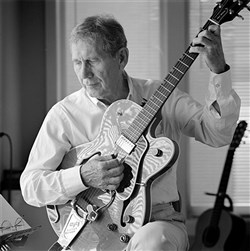
This early ‘90s portrait of Chet Atkins spurred the project that became “Songwriter Musician.”
-- Photos By Ed RodeThe young photographer and the music business legend continued conversing through the event, striking up a friendship that would, a few years later, find Rode in Atkins’ private rehearsal space.
“It was the third floor in the house on Music Row that was his office. There was a big window that this beautiful, gorgeous light would shine through and it hit his guitar, and he would occasionally pick it up and play,” Rode remembers. “One time I asked, ‘Have you ever been photographed up here?’ And he said no. I had my Hasselblad 2¼ (medium format camera) with me, so I instantly set it up, and I’ll be darned if he didn’t sit there and give me a 20-minute concert.
“I sat there,” Rode makes the clunking sound of a manual-wind camera, “and I went through a roll of film, 12 frames, and meanwhile, every note he played was exactly like the record.”
It was while capturing the image that anchors the front section of the “Songwriter Musicians” book that Rode finally asked about what he didn’t know.
“I said, ‘Chet, I’m so hungry to make a documentary, but I’m pretty new to Nashville. What’s this town about? What are we doing? What are the people doing this for?’
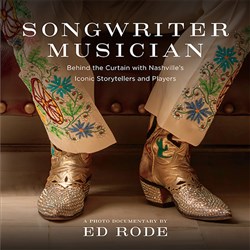
“Songwriter Musician: Behind the Curtain with Nashville’s Iconic Storytellers and Players”
by Ed Rode
c.2024, Ed Rode Photography LLC and Ed Rode
$59.99
192 pages.
Available online and various Nashville retail outlets.
“And he said, ‘Son, you need to be talking to the songwriters and musicians. They’re the backbone of this community. This is how this place works.’
“And I said, ‘Great. Are there a lot of songwriters?’”
Learning the ways
Rode immersed himself in all the corners of Nashville’s music landscape, had been running himself ragged producing work for the afternoon newspaper as well as freelance work making contacts and a name for himself outside the paper.
“Every time I had an assignment, I met somebody else – sometimes I was on assignment and sometimes I wasn’t – where I was mixing Music Row in my job,” he says. “I got married in 1994, and in ’95, my wife (Tracy) looked at me and said, ‘OK, you’re doing 40 hours a week for music and you’re doing 40 hours for the Banner. Something’s got to give.’
“The other thing that pushed that along was I’d won Photographer of the Year three years in a row at the Banner, and had gotten my third raise, but while doing photos for a story on food stamps, realized that at that point I qualified for them.”
Rode decided to make his side hustle his main one, venturing out on his own as an independent shooter. He could be found, camera in hand and questions at the ready, at all the evergreen music biz rituals: the copious No. 1 parties, the Grand Ole Opry, red carpet arrivals and press rooms for the CMA, ACM and CMT awards shows.
But he also embedded himself with the people whose names are usually only found within the almost forgotten art form known as liner notes: songwriters, session players and producers, trying to glean as much information as he could from them while also capturing images of them.
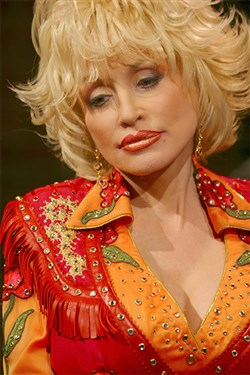
Rode’s journalism instinct told him to keep his lens trained on Dolly Parton for a pensive moment.
He found kinship with artist/songwriters like Guy Clark and John Prine, photographing them in their homes and on the stage, but also with working pros like Don Henry, Wally Wilson, Kenny Greenberg, Gretchen Peters and modern-day prolific writers like Eric Paslay, capturing moments of their quiet inspiration.
Rode knew well the feeling of starting from creative scratch.
“Back in the day, I’d put a blank roll film on my camera, and they would put a blank piece of paper on a desk with a pencil, and they would start with nothing and then they would create.
“I feel like I start with what’s right in front of me,” he continues, “and truly it seems like nothing special, but then – somehow – something is created. If you’re lucky. It doesn’t happen all the time. But if you’re lucky, and if you happen to catch it, you’ve got lightning in the bottle sort of thing. And I think songwriters feel the same way.
“There’s thousands of songs that have been written in this city. And a few of them catch fire and people know them forever,” Rode says. “I think a photographer is lucky to get in on one of those moments, and I feel like I’ve had a few.”
Admirers of Rode’s work share in the idea that he’s caught more than a few great moments.
“The Nashville story and lore needs to be constantly refreshed and revisited,” says longtime Nashville-based music writer Craig Havighurst, editorial director for WMOT Roots Radio 89.5. “We can’t let this history get taken for granted, stuck in a couple of museum exhibits and some books that are on the shelf. It’s really good to have new projects that take us back to a time when you can see a younger Rodney Crowell or the Dixie Chicks in their heyday when they were getting chicken feet tattoos for every hit record.
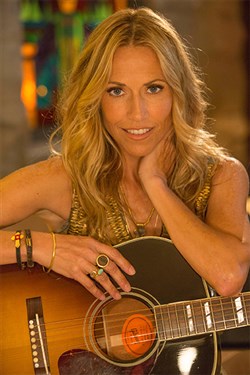
Sheryl Crow
“I’ve been impressed by Ed’s skill at all three kinds of points of the music photography cross, if you will,” says Havighurst, who contributed a foreword to the project. “There’s the formal portrait, the live concert photography and the documentary news photography, and there’s beautiful examples of each of those types of his art in the book.
“And then just finally his enthusiasm resonates with me. I like people who are excited about their stories and about the people they’ve met and about the contributions of those people,” he continues. “It’s not that just that (Ed)’s met them, but that they are the main event in this town and he’s letting you know that he feels so lucky to chronicle them.”
Continuing to grow
Three decades into chronicling Nashville’s creative pros and their output, Rode finds it imperative to keep up with the changes in not only how he creates his own work, but also how he interacts with today’s artists.
On the ongoing question of film versus digital, Rode swears there’s a best of both worlds.
“I love digital, but I love making it look like old film,” Rode says. “Which isn’t necessarily an easy thing to do. It’s probably gotten a lot easier over the years with settings and software, but I’ve used all the old films so I know what things are like.”
On getting the maximum effect with a minimal amount of extra lights, Rode turns to his years of photojournalism experience.
“The simplicity of my style is on purpose because I couldn’t carry lights with me,” he states. “I had film in the early days and then I had some bad digital for a long time before things got really good.
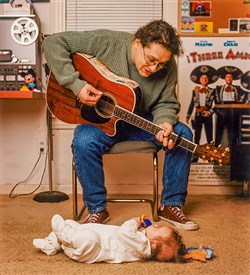
Songwriter Don Henry tries out a new song on young son Dylan.
“So I became a ‘one-light wonder’ because that’s all I could carry in my backpack: one light and gear and cameras and lenses.
“That Willie portrait was done in his bus with one light and one opportunity to spend time with an icon,” Rode says. “So I became really good at using that one light if I needed it to tell a story.”
On the necessary shift of his approach of dealing with artists in the constantly connected media age, Rode says he has one regret.
“The great thing about Nashville in the past was the hang,” Rode says. “The hang was always very loose, and people were very relaxed. It was my side of the business, to hang around some incredible people.”
For some of the newer hitmakers featured in the book, such as Luke Combs, Jelly Roll and Lainey Wilson, Rode had to find a moment of connection with them in a much more compressed time frame.
“Nowadays, these young artists come up, and they come up in a much different world,” he says. “It’s a social media world, so they’re adept at their look, their personality, their presence, so the hang isn’t like it was. It is now a much tighter ship.”
Waiting for The Moment
Many times Rode finds himself chasing the moment within the moment, capturing something the audience doesn’t often get to see within a public-facing event.
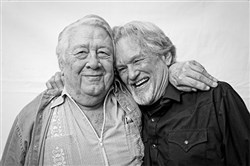
Songwriters Cowboy Jack Clement and Kris Kristofferson share a candid moment.
“I love shooting people before they hit the red carpet or right after, because they’re in a more relaxed position, they’re less formal and they’re more themselves,” Rode says. “I love those unguarded, happy, interesting moments.”
Little did he know in 2006 that a quick chat with a relative newcomer gaining traction via country radio would generate one of his favorite shot, nor did he know she would become the biggest pop star in the world.
“With the Taylor (Swift) shot, we had a great conversation about her new single,” Rode says, referring to her song “Our Song,” the third single off her debut album. “We talked about songwriting for two seconds and how she wrote it.
“Then it was, ‘Hey, do you mind if I shoot a quick portrait of you?’ And she gave me the peace sign and said, ‘Absolutely,’ and then turned around and gave me this look. It was such a wonderful moment that it was my favorite picture all these years later.”
Every photographer even tangentially involved with country music spends a lot of time searching for their “Dolly shot.” Rode found his in the early 2000s, capturing Parton in a pensive moment while seeing footage from her time on “The Porter Wagoner Show,” television appearances that would spin her off into eventual superstardom.
“That’s my photojournalism training,” Rode says of keeping his eyes and lens on Dolly during the backstage moment while others were watching the footage. “Watching, anticipating, being ready for a moment to happen, and that’s hard because these folks are really good, and she is the ultimate professional. I felt like for about three and a-half, four or five seconds, maybe, she let down her guard, and I got it.”
Rode spends a bulk of his professional time these days helping the next generation of photographers – maybe more precisely termed “content creators” – get it. For the past three years, he’s split his time between family (wife Tracy, young adult offspring Edward and Maddy) and commercial work in Nashville and commuting to Murray, Kentucky, where a part-time opportunity has turned into a full-load faculty commitment at Murray State University.
He’s reworked what had been a straight photography curriculum into a more modern storytelling learning situation, having students shoot with the devices readily available to them (i.e., their phones) on the platforms they’ve grown up with, such as YouTube and TikTok. Rode’s approach applies old-school rules to new-school tools, allowing students to create their own portfolio-worthy work before they step foot off campus.
“I can teach theory, and I do, but my kids shoot and when they walk out, they have work that they could show potential employers,” Rode says. “I got the nicest compliment on Facebook the other day, when one of my photo kids got on there, bought a book and left me the sweetest note.
“She went out and now she’s doing exactly what she said she wanted to do, family portraiture and stuff around Murray,” he continues. “And it was such a cool thing to get positive feedback from a student that’s now out doing the work.”
Good way to show what he now knows.